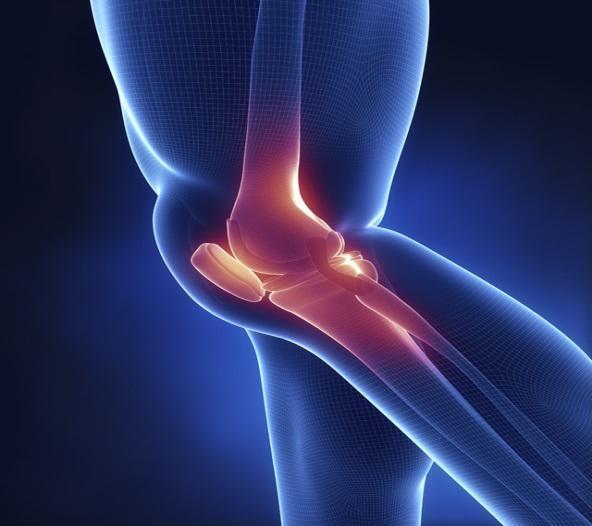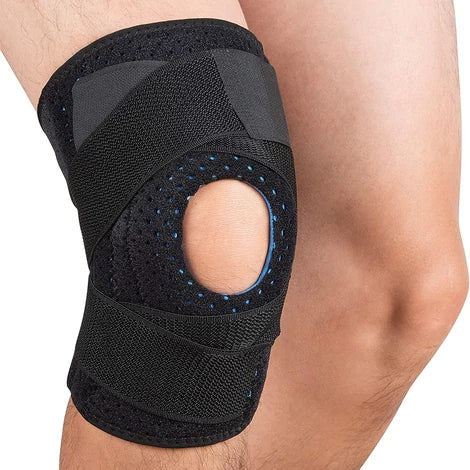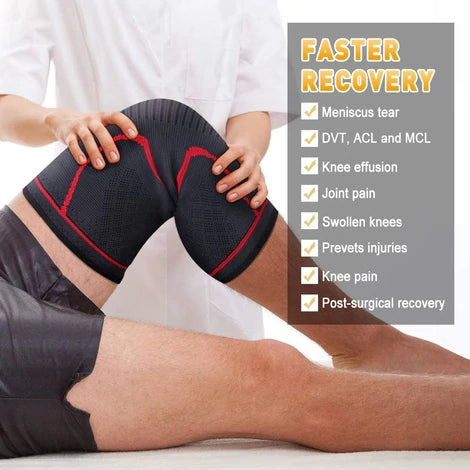
Should I wear patella straps or knee pads for running?
Share
Today, more and more people are beginning to pay attention to their health, and running has become the first choice for most people due to the relatively low technical threshold. With the rise of running fever, all kinds of equipment have also quietly entered the field of vision of runners, from professional running shoes, sweat-absorbing underwear, wearable electronic equipment, and protective gear such as shin and patella straps. Sporting goods merchants are tirelessly developing a wide variety of products, and consumers are also very motivated. No matter whether they are professional athletes or not, the equipment must be equal to the professional level. Today, let’s talk about whether to wear patella straps or knee pads when running?
When browsing the running forums, I often see netizens saying that their knees hurt when running, and the more I run, the more painful it is. Later, it hurts when I go down the stairs. The pain is really unbearable. It doesn't hurt to wear it, and then continue to run! Then many people commented: "When I went to a certain store, the clerk recommended wearing a patella belt, and then I bought one for more than 100 yuan, and found that the knee joint is really more comfortable when running, and there is no more pain. "As everyone knows, they don't know the actual function and usage of sports protective gear at all. This is not to exercise the body, but to weaken the basic function of their knee joints. Seriously, this is running with life! Therefore, it is necessary to popularize the causes and prevention of knee pain during running, as well as the correct use of patella straps and knee pads.
structure of the knee joint
The knee joint is the largest and most complex joint in the human body. It consists of the medial and lateral condyles at the lower end of the femur (thigh bone) and the medial and lateral condyles at the upper end of the tibia (calf bone). The tibiofemoral joint and the patellar surface of the femur and the back of the patella constitute of the patellofemoral joint. Inside the joint are cartilage (meniscus), anterior and posterior cruciate ligaments, and synovial folds that run deep into the joint capsule. It is used to fill the joint cavity, make the two joint heads adapt to each other, and at the same time buffer the friction and vibration between the two bones. Back side to strengthen the joint. The patella is located on the medial side of the quadriceps tendon-patellar ligament in contact with the femur. Its function is to increase the moment arm of the quadriceps femoris to extend the knee during exercise, which usually slides up and down on the femoral patellar surface during exercise. In addition, on the upper and lower edges of the patella, where the ligaments and the bone contact, there is also the synovial sac to cushion the friction during movement.

Causes of knee pain during/after running
For runners, common pain comes from below and just above the knee joint. Knee injuries that often occur in running include: patellar tendinopathy, also known as tendinopathy, etc. These diseases are not a big deal in themselves. As long as the patient stops exercising and rests for a while, they will naturally recover. If they use heat compress, massage or some physical therapy methods at the same time, they can speed up the healing. However, if it is not properly handled and treated, the further development of the disease will evolve into stiffness, tendon calcification, and even intra-articular cartilage fibrosis, osteoarthritis and other diseases, which seriously affect people's quality of life.
So how does patellar tendinopathy happen? Unlike the joints of the upper limbs, the movement of the knee joints bears the weight of the entire body. Studies have shown that the ground reaction force of the foot touching the ground during jogging is 2-3 times of the body weight, and the reaction force of the sole of the foot during fast running and jumping is more than 3 times that of jogging, which is an important cause of knee injury. in factor. The knee joint is one of the most superficial of all joints in the human body and is where the femur meets the tibia, with the meniscus in the middle and the patella in front. The patella is surrounded by the quadriceps tendon, suspended in front of the trochlear joint of the femur, and is very easy to slide, which is the inherent cause of knee injury. Patellar tendinopathy is a degenerative disease caused by excessive use of muscle fibers and repeated strong stretching. In addition to involving the tendon itself, it can also affect the tendon sheath, bone-tendon junction and other positions.
The causes of the above knee injuries from running can be grouped into the following categories:
-
The muscle strength is weak, and the knee ligaments are overburdened during exercise, and repeated friction causes inflammatory factors to infiltrate the tendons
-
Insufficient preparations, excessive muscle viscosity, excessive resistance during forced exercise, and poor muscle contraction
-
Failure to master the correct running posture, deformation of movements, and compensatory use of other muscle groups
-
The exercise intensity and amount of exercise are arranged too large, and the body cannot bear the excessive exercise load, especially the novice who has just started running
-
Fatigue accumulates, the body has not recovered from the joint friction caused by the previous exercise, and immediately starts exercising, which is easy to cause subtle damage, accumulation of inflammatory factors, and protracted and difficult to heal
-
The choice of the climate venue is uncomfortable. For example, exercising in an environment that is too humid and cold for a long time is prone to arthritis; in addition, the venue is bumpy, which will also have a huge impact on the knee joint during running
How to prevent knee injuries
prevention:
-
Master the correct exercise posture
-
Exercise appropriately, including exercise intensity and volume that suits you, do not blindly follow the trend, and stop exercising immediately if you feel unwell
-
Choose better weather and better venues for exercise
-
Make adequate preparations before running
-
Strengthen the muscle strength around the knee joint and enhance the stability of the knee joint (this is especially important and is the fundamental way to solve the problem)
-
Knee pads can be used appropriately. Presumably attentive readers have found that there is no mention of the use of patella straps to prevent running knee injuries
Next, let’s talk about the treatment methods. Knee joint injuries can be divided into acute phase and chronic phase. Generally speaking, the acute phase is within 48 hours of the injury. At this time, three of the RICE principles (rest, ice, compression, elevation) are used. , that is, rest, ice, and elevate the affected limb. And after 48 hours, our approach is:
-
Knee pads to limit the movement of the knee joint and prevent secondary injuries
-
Hot compress, physiotherapy and massage can accelerate the blood circulation of the injured part
-
Seek medical treatment in a timely manner. The most accurate diagnosis is still in the hospital. MRI can basically diagnose soft tissue damage, while the usual X-ray is used to judge fractures
Patella Band and How to Use It
In many professional games, such as basketball, volleyball, tennis, etc., we can often see that the lower edge of the athlete's patella is about a finger-wide band, called the patella band. There are many patella straps on the market, as shown below:

Its main function is to help the patellar tendon bear the impact force during exercise, limit the friction of the patella with the patellar tendon during strenuous exercise, and protect the knee joint.
Suitable crowd:
1. Elderly people who have decreased muscle strength but still need to exercise (such as those with diabetes and hypertension).
2. Athletes who need to keep training after injury (such as athletes with jumping knee, etc.).
People who are not suitable for use:
It is not recommended for novice runners or people with running knee pain, because the main function of the patella belt is to relieve the discomfort or even pain of the knee joint after running. The root cause of this discomfort and pain is the lack of muscle strength around the runner's knee joint, which causes the ligaments to bear excessive load. The principle of action of the patellar band is to help the patellar ligament share the force during exercise, and at the same time stabilize the patella within a certain range to avoid excessive friction. Therefore, the use of the patellar band not only cures the symptoms but not the root cause, but also easily causes the body to over-rely on the auxiliary function of the patella band. Makes already weak muscle groups weaker. After using it for a long time, you will find that as long as you take off the patella strap, your knee joint will hurt when you run.
Therefore, here are some suggestions for you with symptoms of knee discomfort or pain after running:
1) When this symptom is discovered for the first time, it cannot be forced. Because all pain is essentially a signal from the body, once it hurts, stop running immediately and rest, observe, or do some exercises to develop the strength and stability of the knee muscles, such as standing, squatting against the wall, etc.; if you must Running, you also need to adjust the distance and pace in time. When the muscle strength is enhanced, the knee joint will naturally not hurt when running. At this time, you can appropriately increase the exercise load according to your own situation.
2) If this symptom has been present for a long time, but you are still running, stop running first, and then seek medical attention in time. The doctor will give you the most accurate diagnosis and treatment.
Knee pads and how to use them

Knee pads are fabrics used to protect the knee joint. There are two main types, namely: one-piece knee pads and open-hole knee pads.
Related Articles: How to Choose Knee Pads Scientifically
The role of knee pads:
1. Limit knee hypermobility;
Many improper technical movements in sports can easily cause knee injury. The fit of the knee pad makes the knee joint stable during exercise, and wraps the lower end of the quadriceps to limit the hyperextension of the knee joint; the limiting effect of the open-hole knee pad It is stronger and greatly reduces the flexion and extension of the knee joint. Its good compression effect can effectively disperse the pressure on the knee and reduce the risk of sports injuries.
2. Buffer the external force collision of the knee joint and prevent abrasions;
The knee pad has a certain thickness and elasticity, which can buffer the impact force when it collides with a hard object during exercise and protect the knee joint.
3. Keep warm
Especially when exercising in cold weather, the lack of muscle contraction on the knee joint produces heat, and it is easy to catch cold. Cold knees are associated with many diseases, including arthritis. Knee pads can effectively keep warm and prevent the knee joint from getting cold.
Suitable crowd:
1. People who need slight knee braking (for daily sports protection):
In this case, the one-piece knee pad is used, because this knee pad has less effect on restricting the movement of the knee joint, and can play a protective role without overly relying on the knee pad to bear the force. Compared with the patella belt, it is more suitable for running. But you need to pay attention to choose the size of the model that suits you and fully consider the breathability when purchasing. Buying a big one won't do anything, and buying a small one will affect the blood circulation around the knee joint.
2. Runners who need to keep warm can buy one-piece knee pads, or velvet one-piece knee pads.
3. People who need strong knee braking (for the rehabilitation period for injury healing):
In this case, use a thicker one, with a large hole in the front to expose the knee joint, usually a bundled type, and then an open-hole knee pad fixed with a hook and loop. After this kind of knee brace is tied, the knee joint cannot be easily bent, and the thigh and calf are always kept in a straight line with the knee joint, so it is very suitable for "severe braking" after knee injury.










